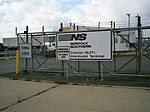Bergen Tunnels
1877 establishments in New JerseyDelaware, Lackawanna and Western Railroad tunnelsNJ Transit Rail OperationsRailroad tunnels in New JerseyTransportation in Jersey City, New Jersey ... and 3 more
Tunnels completed in 1877Tunnels completed in 1910Tunnels in Hudson County, New Jersey

The Bergen Tunnels are a pair of railroad tunnels with open cuts running parallel to each other under Bergen Hill in Jersey City, New Jersey, U.S. Originally built by the Delaware, Lackawanna and Western Railroad (DL&W), they are used by New Jersey Transit Rail Operations (NJT) trains originating or terminating at Hoboken Terminal.
Excerpt from the Wikipedia article Bergen Tunnels (License: CC BY-SA 3.0, Authors, Images).Bergen Tunnels
Elm Street, Jersey City
Geographical coordinates (GPS) Address Nearby Places Show on map
Geographical coordinates (GPS)
| Latitude | Longitude |
|---|---|
| N 40.740277777778 ° | E -74.0625 ° |
Address
Elm Street 2
07306 Jersey City
New Jersey, United States
Open on Google Maps











